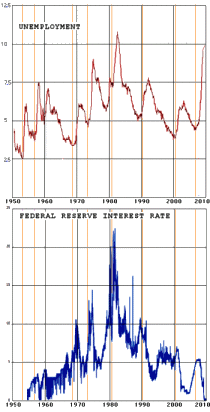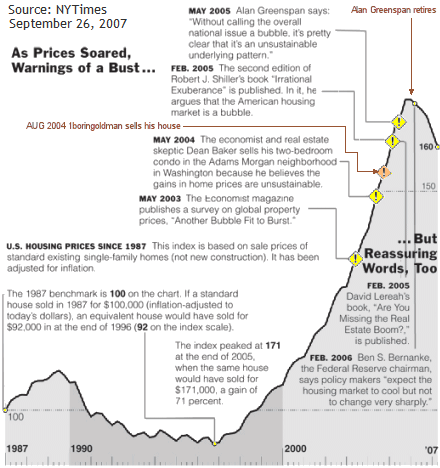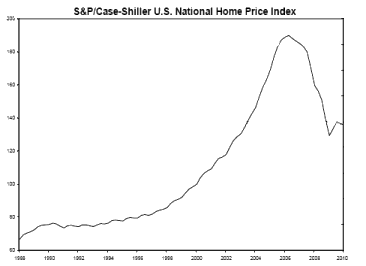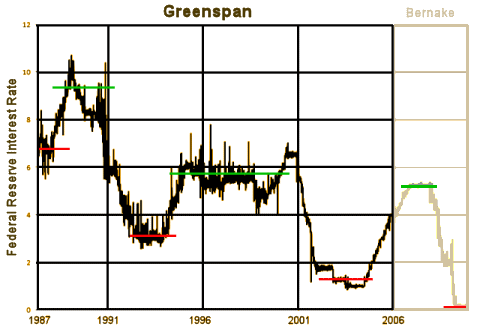Alan Greenspan took over the Fed in August 1987 during Reagan’s waning days. He had a belief. He thought, as many have thought, that the free market economy is self correcting – that it will upright itself under any circumstance. He felt he could deal with setbacks by adjustments in the Interest Rates at the Federal Reserve Bank. Economy sags, lower the rate. Credit improves, money is more available, the economy picks up. He fought against people who wanted to exert more control over the markets. When Brooksley Born took over the CTFC in 1994, she quickly perceived that the Derivitive trading unleashed by her predecessor, Wendy Gramm, could turn into a nightmare. Greenspan and others blocked her attempts to bring this dark market into the light. After 17 trips to Congress in an attempt to make her point, she gave up – largely due to Greenspan’s efforts. That was a terrible mistake.
When Greenspan took over in 1987, the Federal Reserve Rate was low for the time [first red mark] in response to the Recession during Reagan’s tenure. As the economy improved, Greenspan raised the Federal Reserve’s Rate [first green mark]. Towards the end of George H.W. Bush’s term, we had another recession. His first rate drop didn’t work, so he lowered it even further [second red mark], and then brought it back up as things improved [second green mark]. Note that he had to go lower that time, and never got the rate back up to its previous value. In 2001, the dotcom "bubble" burst and he had to lower rates dramatically [down to approximately 1%]. We didn’t really know it then, but there was a new malignant bubble forming – the "housing bubble." Certainly, Dr. Robert Shiller began then to warn us about the "housing bubble." At first Greenspan denied it, but then even after he agreed, he felt the economy could "handle" the "housing bubble." In January 2006, he retired [just as the housing bubble burst]…
 Greenspan’s management at the Fed was different from his predecessors. He followed Paul Volker who had controlled high inflation by tightening the monetary policy with high interest rates. Greenspan was an enthusiastic free market capitalist [of the Ayn Rand variety] who though our economy was resilient and could tolerate the much loosened regulations that came with the Age of Reagan – resisting regulation of the derivative markets. The New Deal Financial Reform had essentially consisted of two major prongs:
Greenspan’s management at the Fed was different from his predecessors. He followed Paul Volker who had controlled high inflation by tightening the monetary policy with high interest rates. Greenspan was an enthusiastic free market capitalist [of the Ayn Rand variety] who though our economy was resilient and could tolerate the much loosened regulations that came with the Age of Reagan – resisting regulation of the derivative markets. The New Deal Financial Reform had essentially consisted of two major prongs:-
Banks were limited in size. Commercial and Investment Banks were separated by law and regulated by the Federal Reserve Board. Accounts were insured by the F.D.I.C.
-
The Markets were regulated by the Securities Exchange Commission [Stock Market] and the Commodity Futures Trading Commission [Commodities Market].
This act was incorporated by reference into H.R. 4577, an omnibus spending bill. It was passed by the 106th United States Congress and signed by President Bill Clinton on December 21, 2000…
The act has been cited as a public-policy decision significantly contributing to Enron’s bankruptcy in 2001 and the much broader liquidity crisis of September 2008 that led to the bankruptcy filing of Lehman Brothers and emergency Federal Reserve Bank loans to American International Groupand to the creation of the U.S. Emergency Economic Stabilization fund.
Given the above-stated chronology, it would appear that the House and Senate versions of the bill were introduced just prior to the Christmas holiday in December of 2000, following George W Bush’s (first) election (in November of 2000), while then-President Clinton was serving out his final days as President. The bill was never debated by the House or Senate. The bill by-passed the substantive policy committees in both the House and the Senate so that there were neither hearings nor opportunities for recorded committee votes. In substance, it appears that the leadership of the Republican-controlled Senate and House incorporated the deregulation of credit default swaps into an omnibus budget bill at a time when the outgoing president was in no position to veto anything. The following article suggests that Bill Clinton and Alan Greenspan endorsed this law The Bet That Blew Up Wall Street though Clinton’s position in 2000 is only suggested, not confirmed or made clear in the report…
So during the time of Alan Greenspan, the New Deal was systematically dismantled [with his help]. The symptoms of our unregulated economy were everywhere [S&L Crisis, Enron, WorldComm, etc], but using the tools of the Federal Reserve [the only thing left of the New Deal], Greenspan was able to "treat the symptoms" [until he couldn’t – as mentioned above]. The crown jewel of the deregulation debacle was the "housing bubble." Here’s an old graphic from the NYT [with a few of my annotations] showing the coming catastrophe.


Case Shiller Index to the present
All of these "sub-prime" mortgages were insured with "credit default swaps" [derivative contracts] which were inadequate when the bubble burst. The rest is history. Alan Greenspan seemed awed with the disaster he helped create. In many ways, he was a wizard like the Wizard of Oz, but we had no real idea what was blowing in the wind when he retired and went back to Kansas. It took over two years after the bursting of the housing bubble for it to ripple throughout the economy, producing a Recession that could have potentially spiraled us into the Second Great Depression. Even with a recovery, we’re still on shaky ground.

Sorry, the comment form is closed at this time.